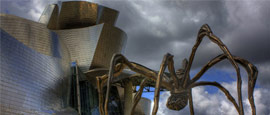Bilbao History
It was not until the 20th century that Bilbao picked up its paintbrush and decorated its own destiny with artistic aplomb.
Before then though, this gritty port was already a palette of colourful history that swirled with wars and was brushed with Basque pride.
It began on 15 June 1300, when Bilbao became a chartered town. Clues confirm the city had been settled before this, mainly along the Ibaizabal-Nervión estuary of the Bilbao La Vieja neighbourhood.
After becoming chartered, Bilbao grew rapidly. It became the main port of the Kingdom of Castile and, in 1372, Juan I of Castile decided to strike while the iron was hot and allow free transportation of the metal through the town.
By the 16th century, Bilbao wasn’t just the economic centre of the Biscay region, but its capital city too.
Bilbao found itself under attack during the Carlist Wars of the 1800s. It survived to tell the tale and went on to become the seat of the Basque autonomous government in the Spanish Civil War in 1936, before being besieged by the Nationalist army, who destroyed all the city’s bridges in May 1937.
Reconstruction began in 1940s and the iron industry picked back up, but the discontent continued in the name of regional pride.
In 1959, the Basque nationalist and separatist group, Euskadi Ta Askatasuna (ETA), was formed here. ETA killed, kidnapped and injured thousands of people in their quest for independence.
Still, the industrial era of the 19th and 20th centuries continued to bring Bilbao wealth. But the city’s aesthetics paid the price.
Business was good until the last decades of the 20th century, when industrial decline set in. A deep economic crisis developed, but after investing heavily in tourism, culture and regeneration, Bilbao turned itself around and became a success story.
Did you know?
• Cava has been called ‘Bilbao water’ here since the early 20th century.
• Steel wool and sand were sprinkled into Bilbao’s first flagstones to stop people slipping in the rain.
• The city commissioned a new font for its street signs in 2000 called the Bilbao Alphabet.
Do you have any Feedback about this page?
© 2025 Columbus Travel Media Ltd. All rights reserved. No part of this site may be reproduced without our written permission, click here for information on Columbus Content Solutions.




 You know where
You know where